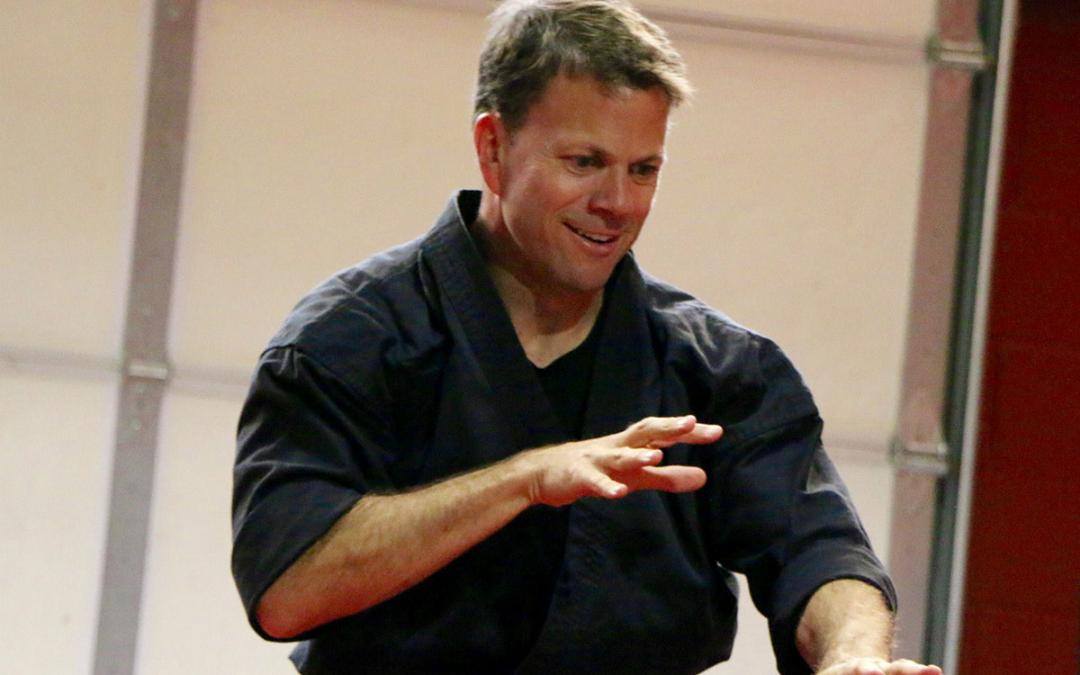Katsu Tame Ni – “In Order to Win”
by David B. Glover
“I’m sorry, but you have cancer.”
I didn’t say anything to the doctor. I didn’t know what to say. I sat there numbly and shook my head slowly from side to side, as I played his words over and over and over in my mind.
I distinctly remember that moment in January 1995 at the National Naval Medical Center (the US Navy’s flagship hospital) in Bethesda, Maryland. Like a ship that abruptly changes course to avoid an unexpected catastrophic collision, my life abruptly changed course to lessen the impact of an unexpected catastrophic illness.
Later, when the radiation oncologist typed up my treatment summary, he wrote: “With this therapy, the patient has approximately a 60-70% disease-free five year survival.”
What did a 30-40% chance of not being disease-free mean? I was afraid to ask.
I understand the relationship of cause and effect and how doing one thing can lead to something else, but I never did not understand the cause of my cancer.
That summer, I came across a phrase: “I have cancer but it doesn’t have me.”
That phrase became my mantra. I obsessively began to pursue fitness with the belief that if I became super fit — even more fit than I already was — then I would beat the cancer and never get cancer again. I started training for triathlons and winning meant beating my competition. Winning meant me against them.
For more than 15 years, my life revolved around triathlon training and racing, leaving little free time for much else. Despite no competitive experience in swimming or cycling, I eventually excelled at triathlon by working hard and focusing on technique. I became an 8-time USA Triathlon All-American and qualified for a professional license from 2007-2009. I finished 28 IRONMAN races (2.4-mile swim, 112-mile bike and 26.2-mile run), winning of them 5 overall and finishing in a fast personal best time of 8 hours and 51 minutes. Ironically, cancer was my greatest strength while racing because I could draw on powerful emotions to drive myself through the discomfort and suffering while racing.
Beating competitors and achieving faster finish times felt euphoric…but only for a brief moment, then the feelings faded and the question came back, “What’s next?”
Over time, my motivation fell and I began to incur more and more frequent injuries. Towards the end of my racing career, I finished races and felt nothing. Competing as a triathlete became empty and meaningless to me.
While on a training ride with friends one summer day in Boulder, I said to myself, “I need a break,” so I turned around mid-ride and never competed as a triathlete again.
In parallel, my life began to also feel empty and meaningless. I lost confidence in myself as my identity as an elite triathlete faded away. My old frameworks, rules and assumptions for living stopped working as effectively as they once had. My career path felt stagnant, and I frequently experienced symptoms of depression and anxiety. I stopped caring about a lot of things, and I disconnected from those around me as I moved my business entirely online and withdrew into my own thoughts.
I wanted more purpose and meaning in my life other than “just putting in time.”
My Path to Black Belt
Since I was a small child, I wanted to become a black belt in martial arts. Black belts in the movies were always awesome fighters who could defend themselves against multiple attackers at once. They moved effortlessly and powerfully as if by magic. I admired my friends who practiced martial arts, as they were more confident than I was and able to stand up to school bullies.
Up through college, I “tried” several other martial arts but none of them stuck with me for more than two or three weeks before I quietly dropped out. I had other things to do.
Still, through all my adult years, I kept my dream of becoming a black belt simmering in the back of my mind. “One day,” I would tell myself but then I turned back to triathlon training or whatever else I was doing at the time.
So, why did I, at the age of 42, walk into the Boulder Quest Center to take my first class in the To-Shin Do® martial art?
I knew absolutely nothing about the Boulder Quest Center other than the dojo taught self-defense classes. I had never heard of To-Shin Do and its founder Stephen K. Hayes who traveled to Japan beginning in the 1970’s to find and train under Masaaki Hatsumi, the 34th Grandmaster of Togakure-ryū ninjutsu. I knew nothing about the art’s historical lineage, which originates from the direct experiences and conflicts of the ninja and samurai more than 900 years ago.
“Why not?” I said at the start of the new year. I had stopped training for triathlons, I wanted to try something new and I remembered my childhood dream.
But, now, the more important question is, “Why stay on this path?”
On the surface, To-Shin Do is about practical self-defense in the real world. Unlike many other martial arts, there are no competitions amongst To-Shin Do practitioners. Students learn to defend against real attacks without any rules that could occur on the street; attacks that have the potential to injure, maim or even kill the defender. The paradox of To-Shin Do is that when it’s done well, it doesn’t look martial arts at all. The attacker attacks, the defender moves and the attacker somehow ends up on the ground leaving the observer to wonder, “What the heck happened?!?!”
Like many other martial arts, there are belt ranks. Every student — no matter their experience or belt rank with other martial arts — starts at white belt then progresses through three belts in each of the five elements — earth, water, fire, wind and void — for a total of fifteen belts on the path to black belt.
The five elements represent energetic states of being and each has its own characteristic actions and responses. For example, when attacked, do I:
- Hold my ground confidently and stand resolutely like a rock in earth?
- Or, step back, evaluate the situation then crash back in like a wave in water?
- Or, move through the aggressor like a wildfire in the perfect timing of fire?
- Or, let the attacker do what he wants to do then compassionately render him harmless in wind?
- Or, seamlessly and creatively move between any element knowing the appropriate action at any given moment in void?
What fascinates me about To-Shin Do is that my training in each element has been a reflection of my life outside of the dojo during that period of time. For example, when I was in the water element, I discovered that water is a natural tendency for my personality, as I tend to step back from situations, think about them for a while then act. This can be a strength because I am cautious and try to understand the big picture before taking rash action, but also a weakness because I may not act quickly enough so miss out on opportunities (i.e., paralysis by analysis).
Why This Path?
During an earth class for new students that I attended a few months ago, the sensei (teacher) discussed the beginning of the To-Shin Do student creed with the class: “I believe in myself. I am confident. I can accomplish my goals.”
The sensei shared how one needed confidence to achieve goals but one needed to first believe in oneself in order to have confidence.
“Wham!” I realized in that moment that I had lost my confidence because I had stopped believing in myself. I realized, too, believing in myself is my choice. I can choose to believe in myself.
In a blog post Stephen K. Hayes shared: “The art of winning is the way of getting what I need in life in such a way that the world is a better place because of it.”1
I had been thinking of myself only as an individual. Triathlon was about me winning by beating my competitors. My battle with cancer was about me not being sick again. My definition of winning was all about me. Although this definition of winning may have felt great for a moment, it wasn’t fulfilling or meaningful. This new definition of winning opens up new possibilities of purpose and meaning in life as my focus shifts from me to we.
These are two examples of the many instances in how To-Shin Do has impacted my life on my path to shodan (1st degree black belt).
So, why stay on the To-Shin Do path?
I stay on this path so I can play big and make a real difference in the world. When I play big, the world is a better place because of it.
In order to play big, I need to unlock more of the hidden teachings, insights and principles that will become available to me after I earn shodan. As such, earning shodan is not an ending but simply a stepping stone on a much longer path.
I stay on this path to master the art of winning.
Cheers,
David
—
 Author of Full-Time and Sub-Nine: Fitting Iron Distance Training into Everyday Life, David Glover has completed 28 IRONMAN distance triathlons (includes two sub 9 hour finishes and winning the Vineman Full Triathlon twice). Now, he helps other triathletes achieve their athletic goals through his online triathlon education and training company, ENDURANCEWORKS. After six years of living in the triathlon mecca of Boulder, CO, David currently resides in California. He is now actively seeking flow state inducing activities and training in ninjutsu martial arts with Shinobi Martial Arts.
Author of Full-Time and Sub-Nine: Fitting Iron Distance Training into Everyday Life, David Glover has completed 28 IRONMAN distance triathlons (includes two sub 9 hour finishes and winning the Vineman Full Triathlon twice). Now, he helps other triathletes achieve their athletic goals through his online triathlon education and training company, ENDURANCEWORKS. After six years of living in the triathlon mecca of Boulder, CO, David currently resides in California. He is now actively seeking flow state inducing activities and training in ninjutsu martial arts with Shinobi Martial Arts.
1. Hayes, Stephen K. “The Art of Winning” (http://www.ninjaselfdefense.com/2014/12/the-art-of-winning/), December 13, 2014.

